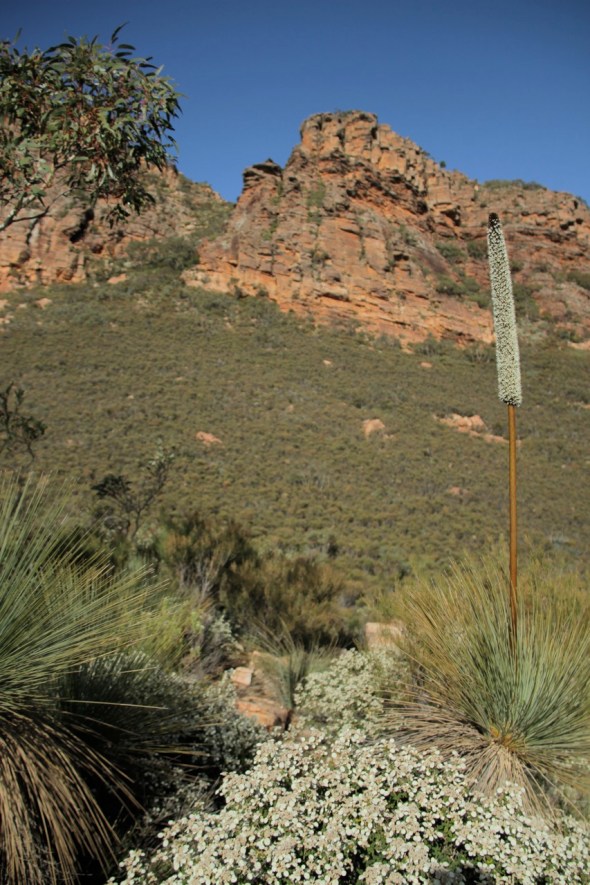Inland and upward
Before Australia’s coastal hills flatten out into the interminable Outback, a worthy collection of the craggy, cliff-laced mountains that are typical of this country rise from Flinders Ranges National Park.
The park is best known for Wilpena Pound, a curiously circular valley surrounded by impassable red cliffs and deep, dry gorges. Once used to hold herds of sheep in the 1800s — and for Aboriginal gatherings long before Europeans arrived— it is now home to kangaroos grazing peacefully in the grasses and low bushes. A lot of them. We also spotted the odd group of mountain goats, introduced to the area long ago, which rangers are now apparently trying to stomp out. Australia has huge problems with their animal populations. There are tons of species that are not supposed to be here (foxes, goats, rabbits, toads, camels), and too many of the ones that are (kangaroos), as we would discover later.
We opted for a 23-kilometer overnight hike, which led us through the floor of the Pound, over the ring of mountains, and back along a forested trail.
After a night in the Pound (and the robbery of half of our dinner by some unwelcome crows) we hiked up to St. Mary Peak, dodging the enormous webs of some large and deeply unsettling spiders that enjoyed hanging just above eye level. The view from the top was well worth it. Rocky, rolling mountain ranges snaked into the distance, melding into the flat, unbroken plains beyond. No doubt there was interesting geology at work here.
So, back to kangaroos. They are everywhere and, as we are now aware, have an unfortunate habit of getting carried away with their hopping and bounding out into the road… right into our red Ford Falcon.
 Judging from what we’ve heard and the numerous carcasses along the road this is very common, and we got off easily compared to the damage a kangaroo incident can incur.
Judging from what we’ve heard and the numerous carcasses along the road this is very common, and we got off easily compared to the damage a kangaroo incident can incur.
After $91 and a few hours in the forgettable town of Port Augusta, the Falcon was still scarred but functional, and we were ready to head into Australia’s vast and rugged interior: the Outback.
There is just one sealed road passing between Adelaide and Darwin, stretching 3,000 kilometers through the deserted interior of the country. The landscape here is excessively flat, covered with dry grasses and low scrubby bushes, along with the occasional stunted tree. Birds of prey circle overhead, and rivers are no more then bone-dry beds of sand.
Though the temperatures are reasonable in the winter, it’s easy to imagine how so many early explorers met their sorry ends out here. We could just picture a weary expedition party coming to the top of a small rise and looking dejectedly out at the endless expanse of yet more nothing before them.
Mostly, it was incredibly boring. Though we caught glimpses of the bright red sand under the scraggly shrubs, we never saw any of the dramatic open expanses of scorched red earth we pictured when we imagined the Outback. We would have preferred an endless wheat field, or at least a few crazy religious billboards like you find in Missouri.
The consequences of succumbing to boredom and letting your eyes and brain wander, however, are dire. As some sort of cruel joke, a large percentage of vehicles traveling the highway are road trains: monstrous trucks towing 150-foot long trailers. Or in other words, untimely and instant death should you swerve into the other lane. Nothing reminds you of the feeble size of your own vehicle or the importance of the dashed center line more than a road train blasting past at 80 mph.
The monotony is broken by several desperate little towns, hardly more than gas stations, with populations barely breaking into double digits. What weird places to live.
The opal mining town of Coober Pedy was one of the most utterly depressing placed we’ve ever seen, a weary-looking settlement of 3,500 people who mostly live underground to escape the summer’s blistering heat, surrounded by countless holes bored into the desolate countryside. We were tempted stay for a few hours and attend a home (Australian rules) football game for a dose of culture, but it was a fleeting thought.
Back on the road, after twelve hours driving through some of the dullest terrain on earth, our brains ached for stimulation — something, anything, to look at. … what’s that you say? A big rock? A mere two and a half hours completely out of our way?
Absolutely.




















Great post! Love the commentary and pictures! Are you 2 tired of trekking yet? You legs must be tired!
June 15, 2011 at 5:26 pm
kangaroos or deer = they all dent fenders!
June 18, 2011 at 12:37 am
hey nate and steph–enjoying the great pics and posts! I think I’d take a kangaroo to the car over the road train!
June 18, 2011 at 5:06 pm
absolutely. enjoy your summer up north!
June 26, 2011 at 12:37 am
Amazing pictures guys, I love following your blog and I can’t wait to see what you do next!I forget how many poisonous critters live throughout Australia- I’m sure youve been cautious/mindful of such things…
miss and love you both!
June 25, 2011 at 1:01 pm
Pingback: Australia by the numbers «